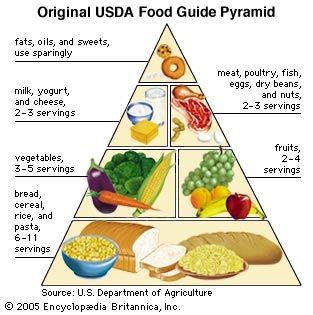The food pyramid is a visual tool representing the optimal number of servings from each basic food group a person should consume daily. This concept, designed to guide healthy eating habits, has evolved significantly over time and across different cultures. But who was responsible for creating this influential dietary guide? Let’s explore the origins and evolution of the food pyramid, focusing on its key creators and adaptations.
The Genesis of the Food Pyramid
The earliest iterations of food guides emerged from necessity. In 1943, the U.S. Department of Agriculture (USDA) introduced the Basic 7 food guide to assist U.S. citizens with food rationing during World War II. This guide categorized foods into seven groups, including bread and cereals, fruits and vegetables, and meat and poultry.
However, the concept of a pyramid-shaped food guide originated in Sweden in the 1970s. Faced with rising food costs, the National Board of Health and Welfare initially proposed a two-tiered system: “basic” and “supplementary” foods. This categorization proved problematic due to the inclusion of essential nutrients like fruits, vegetables, and meats in the “supplementary” category. The Swedish government also experimented with a dietary circle divided into seven sections.
Anna-Britt Agnsäter: The Architect of the Food Pyramid
The person credited with designing the first food pyramid is Anna-Britt Agnsäter, an educator working for a Swedish grocery cooperative. In 1974, Agnsäter introduced her food pyramid in the cooperative’s magazine.
Agnsäter’s pyramid featured three levels:
- Bottom Level: Bread, grains, legumes, potatoes, and milk.
- Middle Level: Fruits, vegetables, and juices.
- Top Level: Eggs, meat, and fish.
The pyramid shape was intentionally chosen to visually represent the proportions of each food group that should be consumed, with the base representing the foods that should be eaten most frequently and the apex representing those to be eaten sparingly.
The USDA’s Adaptation and Evolution
In 1992, the USDA adapted the food pyramid concept for the United States, creating its version with four levels.
This pyramid recommended 6 to 11 daily servings of bread, cereal, rice, and pasta at its base. The second level was divided between vegetables (3 to 5 servings) and fruits (2 to 4 servings). The third level included milk, yogurt, and cheese, as well as meat, poultry, fish, dry beans, eggs, and nuts (2 to 3 servings each). The top level consisted of fats, oils, and sweets, to be consumed sparingly.
The USDA’s adaptation spurred the creation of similar pyramids tailored to specific cuisines and diets, such as Asian, Mediterranean, vegetarian, and vegan. In 2005, the USDA introduced MyPyramid, featuring colored stripes and an emphasis on exercise, and in 2011, MyPlate, which divided a plate into sections for fruits, grains, protein, and vegetables.
Global Variations and Debates
Many countries around the world have adopted and adapted the food pyramid concept, sometimes moving away from the pyramid shape altogether. Canada used a rainbow, Zimbabwe a square, and Japan a spinning top design. These variations reflect cultural differences, design preferences, and differing nutritional recommendations.
The food pyramid has faced criticism for oversimplifying dietary guidelines, failing to adequately differentiate between types of carbohydrates and fats, and not reflecting the complexity of nutrients in foods. Despite these criticisms, the food pyramid and its variations have served as valuable tools for promoting healthy eating habits worldwide.
Conclusion
While Anna-Britt Agnsäter is credited with creating the original food pyramid, the concept has been significantly shaped and adapted by organizations such as the USDA and various countries to align with their nutritional guidelines and cultural contexts. These visual guides continue to evolve, reflecting our growing understanding of nutrition and healthy eating.

